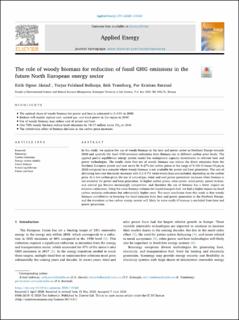| dc.contributor.author | Jåstad, Eirik Ogner | |
| dc.contributor.author | Bolkesjø, Torjus Folsland | |
| dc.contributor.author | Trømborg, Erik | |
| dc.contributor.author | Rørstad, Per Kristian | |
| dc.date.accessioned | 2022-03-11T12:41:31Z | |
| dc.date.available | 2022-03-11T12:41:31Z | |
| dc.date.created | 2020-10-23T07:09:16Z | |
| dc.date.issued | 2020 | |
| dc.identifier.citation | Applied Energy. 2020, 274 . | |
| dc.identifier.issn | 0306-2619 | |
| dc.identifier.uri | https://hdl.handle.net/11250/2984659 | |
| dc.description.abstract | In this study, we analyse the use of woody biomass in the heat and power sector in Northern Europe towards 2040 and quantify the fossil GHG-emission reductions from biomass use at different carbon price levels. The applied partial equilibrium energy system model has endogenous capacity investments in relevant heat and power technologies. The results show that use of woody biomass can reduce the direct emissions from the Northern European power and heat sector by 4–27% for carbon prices in the range of 5–103 €/tonne CO2eq in 2030 compared to a scenario where woody biomass is not available for power and heat generation. The cost of delivering heat and electricity increases with 0.2–0.7% when wood chips are excluded, depending on the carbon price. At a low carbon price, the use of natural gas, wind, and coal power generation increases when biomass is not available for power and heat generation. At higher carbon prices, solar power, wind power, power-to-heat, and natural gas become increasingly competitive, and therefore the use of biomass has a lower impact on emission reductions. Using the same biomass volumes for liquid transport fuel, we find a higher impact on fossil carbon emission reductions but substantially higher costs. The main conclusion from this study is that woody biomass contribution to lowering the fossil emission from heat and power generation in the Northern Europe, and the transition to low carbon energy system will likely be more costly if biomass is excluded from heat and power generation. | |
| dc.language.iso | eng | |
| dc.title | The role of woody biomass for reduction of fossil GHG emissions in the future North European energy sector | |
| dc.type | Peer reviewed | |
| dc.type | Journal article | |
| dc.description.version | publishedVersion | |
| dc.source.pagenumber | 13 | |
| dc.source.volume | 274 | |
| dc.source.journal | Applied Energy | |
| dc.identifier.doi | 10.1016/j.apenergy.2020.115360 | |
| dc.identifier.cristin | 1841685 | |
| dc.relation.project | Norges forskningsråd: 255265 | |
| dc.relation.project | Norges forskningsråd: 257622 | |
| cristin.ispublished | true | |
| cristin.fulltext | original | |
| cristin.qualitycode | 1 | |
